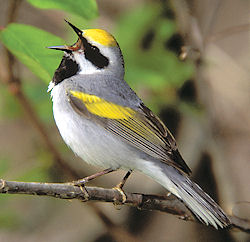Reunification
For up-to-date information regarding the reunification of Penn State's two law schools, please click here.
For up-to-date information regarding the reunification of Penn State's two law schools, please click here.
February 26, 2010
What started out for Anna Sewell, class of 2010, as a paper for a challenging seminar class has become a formal petition to protect an environmentally threatened species. Sewell identified the five-inch, golden-winged warbler as a species in decline and began the rigorous research required to file a petition with the U.S. Fish and Wildlife Service to have the bird listed as endangered or threatened.
“My interest in environmental law is ultimately driven by my desire to protect wildlife and natural resources,” said Sewell. “The petition presented an opportunity to use my course work to begin fulfilling this objective.”
 |
| The golden-winged warbler (Photo by Roger Erikkson courtesy of Birdscope/Cornell Orinthology Lab) |
Professor Jamison Colburn, who teaches a seminar on endangered species, advised Sewell on the process. In his four years of teaching the course, Colburn said that Sewell is the first student who converted the required paper into a full-blown filing. “The Endangered Species Act, a federal statute enacted in 1973, only protects imperiled species if they are listed as either ’threatened’ or ‘endangered’. Anna's petition is aimed at triggering the Act's protections by having this species listed,” Colburn explained. Currently, over 1,800 species are listed and some 250 more are pending.
To prove that the warbler is threatened, Sewell tapped into research done by the National Audubon Society and the Cornell Lab of Ornithology. Retired Professor John Confer, director of Environmental Studies at Ithaca College, who has conducted extensive studies of the golden-winged warbler population, said he considered filing a petition himself.
“Of the states with recent and current breeding golden-winged Warblers, intensive surveys found there are now at least fourteen states with fifty-six or fewer territorial males, and of these states, ten have ten or fewer territorial males.” Confer added that none of those states “can hope to sustain a golden-winged Warbler population."
Reasons for Decline and Potential Remedies
Another part of the petition addresses the reasons for the decline and potential environmental remedies. The highest growth period for the warbler was during colonial times when colonists began farming. But because of the loss of farmlands and reforestation, the bird's habitat is dwindling. This presented a dilemma for Sewell as an environmentalist. “In the beginning of my research, I was concerned that I had inadvertently chosen a species that depends on human disturbances such as farming, burning, and logging for its survival.” Sewell credits Professor Colburn’s guidance and reading recommendations, including Forests in Time: The Environmental Consequences of 1,000 Years of Change in New England (edited by David R. Foster and John D. Aber), with turning around her thinking.
“There are responsible ways to prevent the extinction of disturbance-dependent species,” Sewell said. “A broad historical viewpoint is necessary to fully understand the conservation needs of this species…we must stabilize the population before the bird becomes extinct, and research suggests we need to take proactive disturbance measures alongside our forest conservation efforts. In other words, we should aim for a holistic approach to species conservation in an attempt to protect the greatest number of species possible.”
Sewell added that there are other threats to the survival of this species as well, including interbreeding and possible nest parasitism by brown-headed cowbirds. The U.S. Fish and Wildlife Service has ninety days to determine whether Sewell’s petition merits further study and then it can take up to a year to determine whether or not to list the species as threatened or endangered. If that happens, the service would have to develop a recovery plan to enhance the survival of the warbler.
“My ultimate goal is for the warbler to be listed as a threatened or endangered species under the ESA, but even if the service decides a listing is not warranted, the petition should generate awareness and research into the protection of this bird,” Sewell explained.